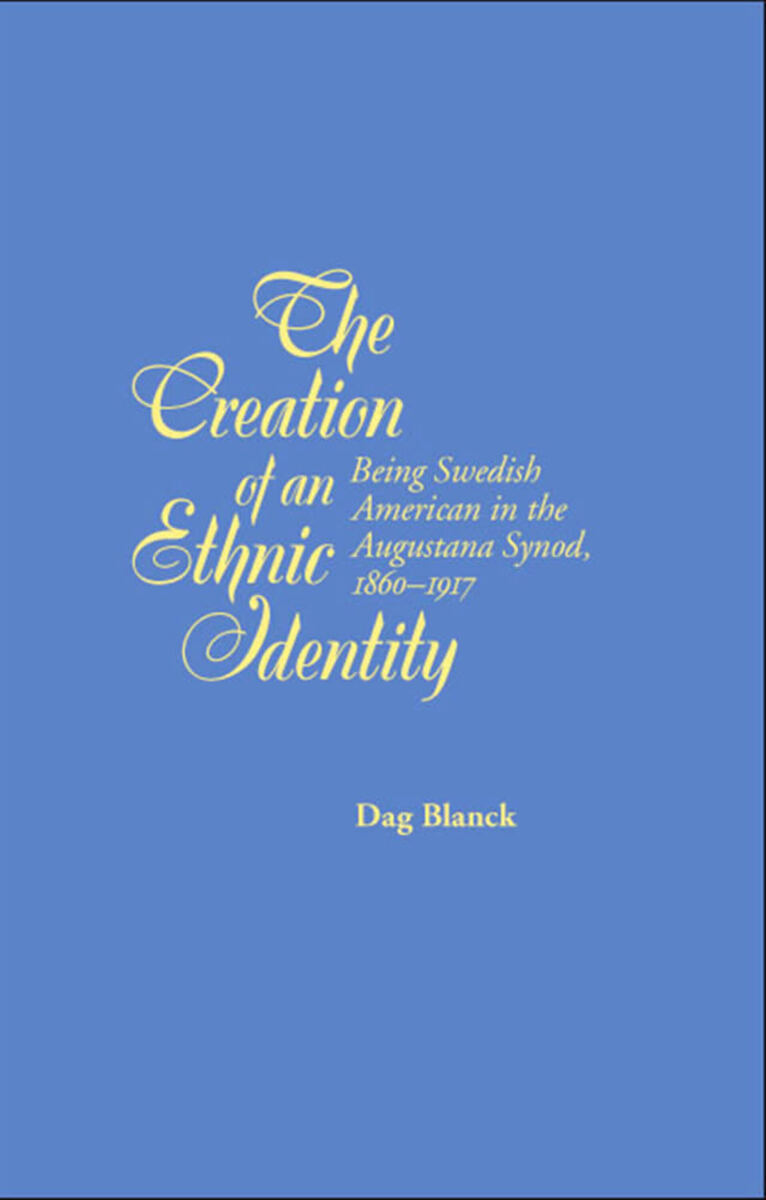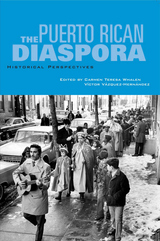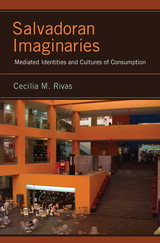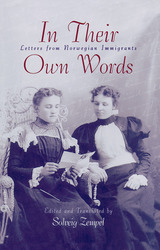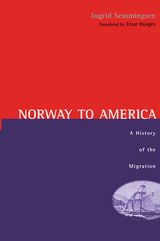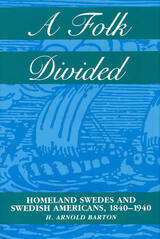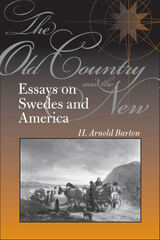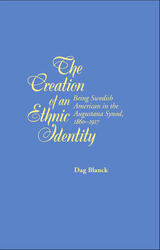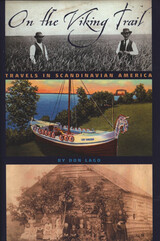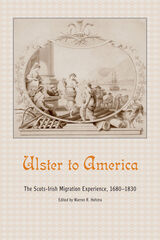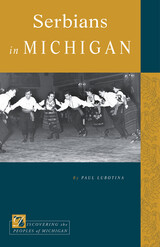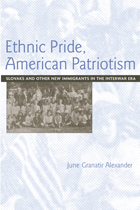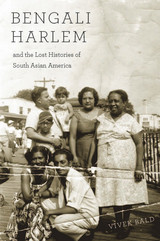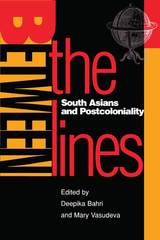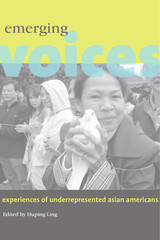Cloth: 978-0-8093-2715-7 | eISBN: 978-0-8093-8951-3
Library of Congress Classification E184.S23B544 2006
Dewey Decimal Classification 305.839707309034
Analyzing the development of a Swedish American identity
The Creation of an Ethnic Identity: Being Swedish American in the Augustana Synod, 1860–1917 analyzes how Swedish American identity was constructed, maintained, and changed in the late nineteenth and early twentieth centuries. The Augustana Synod, the largest religious-based organization created by Swedish immigrants in the United States, played an important role in establishing what it meant to be Swedish American.
In this study, author Dag Blanck poses three fundamental questions: How did an ethnic identity develop in the Augustana Synod? What was that identity? Why was an ethnic identity formed? Based on primary sources formerly unknown or neglected, The Creation of an Ethnic Identity examines the Lutheran Augustana Synod, Augustana College, and the Augustana Book Concern to provide insights into how ethnic identity is constructed within a major religious body, a central educational institution, and a major publishing house.
Starting from the concept of ethnicity as something created or invented, Blanck goes on to explore how it was possible for a white European immigrant group like the Swedes to use its ethnicity as a tool of integration into American society. The nature of their ethnicity, says Blanck, was both determined by their cultural origins and also the values and nature of American society as they perceived it. Becoming Swedish American was also a way of becoming American.
The volume, which is augmented by illustrations, integrates the most critical scholarship on immigration and ethnicity over the past half century and provides a strong argument about how ethnicity is shaped over time within an immigrant group.
Dag Blanck is an assistant professor at the Centre for Multiethnic Research at Uppsala University in Sweden and the director of the Swenson Swedish Immigration Research Center at Augustana College in Rock Island, Illinois.
The present book is a revised and updated version of Dag Blanck's Ph.D. dissertation, originally publishedin Sweden (1997). It addresses the question of identity formation within the Augustana Synod, the most important Swedish American Lutheran body, from its founding in 1860 to American entry into World War I. Inspired by Eric Hobsbawm and Terence Ranger's path-breaking collection, The Invention of Tradition (1983), and Benedict Anderson's equally important Imagined Communities (1983), Blanck sets out to investigate how the leadership of Augustana actively sought to construct a specifically Swedish American identity. Furthermore, challenging the view that boundary maintenance is more important for ethnic identity formation than the "cultural stuff" inside, Blanck analyzes what constituted this identity. Finally, Blanck grapples briefly with the question of why an ethnic leadership attempted-with considerable success-to foist its views of identity on the whole Swedish American community.
In pursuing these objectives, Blanck follows three lines of investigation. First, he studies the educationalsystem at the synod's oldest and largest educational institution, Augustana College, investigating both academic curricular developments and various extracurricular activities, such as student literary societies and ethnic festivities. Blanck also analyzes the makeup of the student body, most of whose members, it turns out, remained within "the Augustana sphere" throughout their careers, many of them as ministers.
Second, Blanck examines the activities of the Augustana Book Concern (ABC), in his view "one of the most important building blocks in the creation of a Swedish-American identity within the Augustana Synod" (p. 159). The ABC functioned as a cultural gatekeeper, importing many works of nineteenth-century established romantic authors from Sweden but excluding others, notably those of modern writers considered immoral. The ABC also published books itself-almost half of them nondenominational-again informed by the synod's "special perspective." Among these publications, schoolbooks figured prominently and are especially worth analyzing, since they may be expected to mirror the leadership's ethnic ambitions.
Finally, Blanck explores the establishment of a Swedish American historical tradition within the synod. Finding inspiration in Orm Overland's concept of "home-making myths" (Immigrant Minds, American Identities: Making the United States Home, 1870-1930 [2000]), Blanck notes how a specifically Swedish American tradition was created out of such elements as the early Swedish presence in North America, myths of ideological gifts (claiming Swedish American contributions to the American Revolution and to the concept of freedom), and the celebration of "culture heroes" such as Civil War engineer John Ericsson and Swedish King Gustavus Adolphus. The establishment of an annual "Founders Day" at Augustana and the celebration of the synod's 1910 "Golden Anniversary" helped sustain these traditions.
Blanck's main thesis is that the 1890s were pivotal for the establishment of a specifically Swedish American identity. Before that point, the Augustana Synod was dominated at both grass-roots and leadership levels by Swedish immigrants with strong local and regional Old World attachments, as well as powerful ties to nineteenth-century Swedish low church revivalism, and only weak ideas about national identity. From the 1890s, with immigrants from an urbanizing and industrializingSweden still arriving in America but many of them now displaying only limited interest in the Swedish American community, the synod became dominated by second-generation Swedish Americans from the traditional areas of recruitment in the Midwest. Under these circumstances, the leadership set out to construct a specifically Swedish American identity out of Swedish, American, and Swedish American components: "This ... actively formulated ethnicity of the second phase was thus radically different from the unreflected upon and taken-for-granted sense of Swedish identity presumed during the first period of the synod's history, and we can thus say that the Augustana Synod went from being Swedish to being Swedish American" (p. 194).
In this well-conceived study, a couple of points do invite criticism. First, Blanck distinguishes between ethnic and religious identity, seeing a separate ethnic identity developing from the religious roots during the 1890s. Since the concepts of religion and ethnicity overlap, Blanck's alternative juxtaposition of the religious element with "cultural traditions" is more precise (e.g., pp. 7, 9, 68-69, and 192). Second, Blanck all but excludes the contemporary political context from his investigation, even though George M. Stephenson, in his classic study The Religious Aspects of Swedish Immigration:A Study of Immigrant Churches (1932), emphasized the Augustana Synod's powerful Republican sympathies and basic conservatism. A stronger focus on the political environment would have led Blanck to consider Theodore Roosevelt's xenophobic "anti-hyphenate" campaign in his discussion of a 1916 Swedish American article titled, "Shall We Do Away With the Hyphen?" (pp. 157-158). More critically, the ethnically virulent atmosphere is ignored completely in connection with Blanck's crucial analysis of a Swedish American schoolbook published on the eve of American entry into World War I (pp. 145-150).
These points should not detract from the fact that Blanck has written a scholarly and well-argued book. Students and scholars studying ethnic identity formation, as well as people interested in Swedish American and Scandinavian American history, will read it with great benefit.
Recently in the pages of this journal, Matthew Jacobson made a compelling plea for a greater sensitivity toward the transnational character of the field of immigration and ethnoracial history. Citing Oscar Handlin and John F. Kennedy, among others, he stressed the ways in which the field is inherently transnational, yet how the national has often intruded on our scholarship. As persuasive as Jacobson's point is regarding the field, his essay revealed an incomplete appreciation of its historiography. The work of W. I. Thomas and Florian Znaniecki, Dorothy SwaineThomas, Frank Thistlethwaite, and Marcus Lee Hansen, to cite only a few examplesfrom which Handlin and Kennedy might have profited, had explicitly transnational elements. Each in his or her own way attempted to view emigration and immigration as an integrated process that wed world capitalist development and the turn to modernity into a comprehensive whole. As scholars have recently rediscovered the transnational wheel, their understanding of those who preceded them is often lacking.
I write this in the context of this review because scholars who have focused on the Scandinavian migration - including Hansen and Thomas, but also Theodore C. Blegen, Ingrid Semmingsen, Kristian Hvidt, and Harald Runblom - have been remarkably transnational in their conceptualization of it. The books considered inthis review, particularly those by Dag Blanck and H. Arnold Barton, illustrate that this understanding endures. Both in their own way, Blanck and Barton exhibit an understanding of the developments in the United States and the Swedish homeland.Odd Lovoll's orientation, in contrast, because his unit of analysis is the small town, is neither national nor transnational, but rather localist.
Lovoll has long been fascinated by the small town in the Norwegian American past, and his study of Benson, Minnesota, addresses this interest. Whereas Norwegian immigrants were among the most rural of any ethnic group in the United States, they were instrumental in the growth of midwestern small towns as well. And whereas scholars have focused their attention on the Norwegian farmer and big-city dweller, they have, Lovoll argues, given short shrift to the small town story. Lovoll's richly illustrated narrative thus fills a void, and he provides us with a lively description of Benson over a century and one-half. (In the interest of full disclosure, I should say that I reviewed Lovoll's book for publication.)
Benson, located in Swift County in western Minnesota, had Norwegian American residents from its inception and continued to be associated with Norwegian America as a result. To be sure, the town contained those from a variety of backgrounds, including Yankee elements that dominated the financial institutions and the professions. Despite this heterogeneity, much of the business of the town was conducted in the Norwegian language. Even non-Norwegian businesses made efforts to attract Norwegian American customers, and their proprietors attempted to learn Norwegian.
Perhaps the most interesting element, which foreshadows the discussion of Blanck and Barton to come, is the flowering of ethnicity in the twentieth century. Lovoll notes that a matrix of Norwegian institutions grew in the early decades of the century. Even more interesting is his discussion of what he calls the persistence of ethnicity later in the century, when leaders discovered that they could market ethnicity. Small towns vied for the honor of being the "Lutefisk Capital" of the nation; they competed to see which burg could roll the largest piece oflefse, flatbread made from potatoes; and Benson claimed what might be considered the dubious distinction of being the "klubb capital of Minnesota," the state's hub for the production of heavy potato dumplings.
Lovoll's is a valuable study, but it is unclear to me whether its subject is Norwegian America or the peculiarities of immigrant ethnicity in a small town. On the onehand, the story of Benson is set in the Norwegian American past with discursionsinto such topics as the larger patterns of Norwegian migration. On the other, Lovollgrapples to some degree with the variety of ethnic groups in this small town, a topic dealt with in the past by figures as diverse as Sinclair Lewis and Merle Curti.
Whereas Lovoll's study is a focused case study of one small town, Dag Blanck'sstudy is a careful analysis of the Augustana Synod and its role in shaping a Swedish American identity in the late nineteenth and early twentieth centuries. The Swedish presence in the United States in this era was substantial. Some 1.3 million Swedes moved there during the century of migration ending in 1924. As a literate population, their output of print media was even more remarkable. The Swedish American press was the second largest foreign-language press in the United States(after German language imprints) in 1910. Blanck demonstrates that the AugustanaSynod, the largest religious organization among Swedish Americans, was the most significant Swedish American institution. By the 1920s, Blanck clearly shows, at least one-quarter of Swedish Americans were affiliated with the Synod (p. 33).
Blanck's argument has two interconnected components. First, the content of ethnic expression was transformed in the half century after 1860, and, second, the shifting patterns of identity among those who identified as Swedish American werepivotal in this transformation. In the three decades after 1860, Swedish Americansattached relatively little significance to a Swedish American ethnicity. Rather, they relied on an extant Swedish literature and simultaneously placed less emphasis on the preservation of Swedish language in the United States. Blanck argues that this approach resulted from two facts: the relatively weak Swedish American institutional structure between 1860 and 1890, and Swedish Americans' less-than-secure class position in the United States.
Around 1890, an identity shift began to occur. No longer as interested in the English language and assimilation, Swedes in the Augustana Synod began to emphasize the importance of the Swedish language and the creation of a unique Swedish American culture. In this second phase, then, Swedish ethnicity emphasized, and began to coexist with, a Lutheran identity. Ironically, Swedish Americans, many of whom were not born in Sweden, sought to create an ethnic identity with little familiarity of the Sweden that their parents forsook. Whereas Swedish Americansin the first phase simply relied on Swedish classics, those in the second period had to construct their Swedish American identity.
This transition is related to Blanck's second point: the transition of Swedish America to one increasingly of American origin. After painstakingly researching the backgrounds of the students of Augustana College, Blanck shows that American-born Swedish began to dominate the student body after 1890. Moreover, children with white-collar backgrounds, rather than the sons and daughters of farmers and laborers, also came to predominate. Blanck, ever alert to changes taking place in Sweden, notes that these students developed an idealized view of Sweden, characterized by romanticism, patriotism, and idealism, just like their counterparts across the Atlantic.
Blanck explores the content of this Swedish American identity and notes the ways in which it conforms to the "homemaking myths" outlined by Orm Overland in his 2000 study. The myths stressed the role that Sweden played in the foundation of America, stemming from both the Viking discoveries and the early colonial settlements in Delaware. Swedish Americans outlined as well the ideological gifts, most notably in the form of political freedom that they argued typified the early Scandinavian government. Finally, the homemaking myths underscored Swedish America's blood sacrifice in war, most notably in the American Revolution and the Civil War. With cultural heroes such as Gustavus Adolphus and John Ericcson, who invented the Union's first ironclad ship, Swedish Americans could tell a storyof their role in the American pageant. Swedish Americans were at the forefront of promoting core values in the American myth: the creation of a republic that promised liberty and a nation that later destroyed the menace of slavery. Blanck thus underscores the ways in which the second generation's identity creation was part of its strategy to interact with American society. As Russell Kazal has noted with regarded to "old-stock" Germans, Swedish American mythmaking was cognizantof the larger American myth. It enabled Swedish Americans to place themselves in the racial and ethnic hierarchies of the time. Thereby, Blanck concludes, "Swedish immigrants and their children living in turn of the century America were, by becoming Swedish American, also becoming American" (p. 201).
H. Arnold Barton has provided us with a collection of essays of previously published pieces, most of which appeared in the Swedish-American Historical Quarterly. The essays are arrayed chronologically, beginning with the colonial migration and followed by the early migrants in the Janssonist movement, the massivemigration in the late nineteenth and early twentieth centuries, and the diminishing migrant streams after 1924. Barton's topics are eclectic, including a consideration of immigrant letters, the place of women in the Swedish American community, and the curious partnership and rivalry between Norwegian and Swedish immigrants in the United States.
In this review, however, I will focus on the core of Barton's work, which grappleswith Swedish American identities and their relationship to developments in Sweden and the United States, and which therefore nicely complements Blanck's study. Barton has published widely on this topic in the past, and this collection is a nice primer on his previous work. One of the strengths of Barton's work is his sensitivity to conditions in Sweden that informed the Swedish migration story, with Swedes reactingin a variety of ways to massive migration to America. Swedish observers,from the beginning of the migration in the mid-nineteenth century, puzzled over themeaning of the migration itself. Some were strongly opposed to the it because they saw emigrants as vain profit seekers who were betraying Mother Sweden. Others wished to investigate the problem of emigration and its meaning for contemporary Sweden. Still others saw Swedish immigrants as .inheritors of the greatness of Sweden and as the best and truest Americans.
By 1900, three distinctive schools of thought had crystallized that reflected thesepostures, which had as much to say about contemporary Sweden as to the meaningof the migration. Those who decried the emigration formedNationalföreningen mot emigrationen (National Society against Emigration), a conservative group which encouraged a remigration that, it believed, would nurture a stable rural population and strengthen Sweden by forestalling the temptation of the city and internationalist social movements. Those who wished to study the problem of emigration found their calling by contributing to a multivolume study - published around the time of the Dillingham Commission report in the United States - that was aimed at fostering social reform in an industrializing society. And those who celebrated the emigration established Riksforeningen for svenskhetens bevarande i utlandet (The National Society for the Preservation of Swedish Culture in Foreign Lands),a group that aimed at seizing the opportunity of "overseas Swedes" to enrich and empower Sweden.: Each of these groups lost strength as world war and reduced emigration streams diminished the emigrant problem, but each had reflected an important element in Swedish society. The National Society against Emigration reflected a romantic and bucolic view of Sweden. The scholars, who studied the emigrant in the context of an industrializing society, provided a blueprint for the evolution of Sweden's response to industrialization and its social welfare system. And those who looked to overseas Sweden reflected a transnational perspective that is so common today in national communities in many nation-states.
As Swedes reacted to the emigration, Swedish Americans constructed an ethnic identity. Again, Barton is attentive to the historical conditions that informed the development of these identities. Like Blanck, he argues that Swedish Americans in the early phases of the migration were less concerned than later with the preservation of their Swedishness. Many wished to learn English; many abandoned theLutheran church; most wished to assimilate into American life. Following Blanck,he notes that Augustana College stressed the importance of the English language inits early years. Why? Part of the answer lies in the Swedish past. Barton explainsthat the early immigrants were leaving a land that was experiencing a rapid decline in its folk culture, which was being replaced by an acceptance of urban gentility. Religious awakenings, moreover, were coursing through the Swedish countryside,and peasants, whether they emigrated or not, were concerned with a proper pietisticperspective rather than accepted tenets of Lutheranism. Finally, the emigrants didnot have a strong Swedish consciousness. They were understandably more attachedto ties of kinship and to their home community than to the Swedish state and nation.These perspectives, transferred from Sweden, were complemented by conditions inthe United States. Without a solid ethnic institutional structure, and hoping to attainthe age-old peasant dream of economic independence, early Swedish immigrants lived in local communities that often did not place a high priority on creating a Swedish-specific institutional structure.
All of this changed amid the massive migration in the late nineteenth and earlytwentieth centuries. An increasingly large Swedish American community fostered the growth of an institutional structure-a Swedish-language press, churches and colleges, and ethnic organizations-that placed a premium on sponsoring a sense of Swedishness in the United States. As return migration became increasingly common, moreover, the ties to the homeland were less likely to be attenuated. Atthe same time, Swedish America was influenced by a national romantic movementoccurring in Sweden that created a heightened sense of patriotism and appreciation of Swedish folk culture. The outcome of these changes was twofold. First, an increasingly complex institutional structure was formed that was less localist in nature and cultivated a national Swedish tradition. The Swedish language was standardized and increasingly valued as a component of the Swedish American identity. In effect, this was an example of "peasants becoming Swedish" in the United States. Related to this was a second outcome: the content of this tradition itself. The architect of the tradition was Johan Alfred Enander, longtime editor of Hemlandet, the Swedish newspaper in Chicago. Enander's work is another example of Overland's "homemaking myths." He argued that the Vikings were instrumental in enabling the "freedom" that spread not only throughout the British Isles, but America as well. Swedes, moreover, were among the first founders of America with their New Sweden colony in Delaware; in fact, they were more honest than the cynical and avaricious Dutch and English. Swedish America was present in Congress under the Articles of Confederation period, and its role was momentous in fighting the war against slavery. As a paragon of freedom and the struggle against unfreedom, and as an exemplar of the courage of the Vikings in contrast to the papist Columbus, Swedish America could use its myth to stress its position as loyal adherents to the larger Protestant American myth.
Barton and Blanck clearly illustrate the complementarities and conflicts betweenand among Swedes, Swedish Americans, and the larger American community. Both have their faults. Blanck often reads like the published dissertation that it is; it often is overly repetitive in summarizing its major findings. Barton is a collection ofpreviously published essays. It is organized chronologically, but there still is much overlap, and the essays - because they are essays - do not hang together very well. Still, these volumes, taken together, have much to say about the created identities of ethnic groups in the United States and their encounters with the homelands and their new homes.
Both Blanck and Barton, despite their varying units of analysis, illustrate the service of transnational perspectives to the field. To be sure, Blanck's story is national and ethnic, focused on the ways in which an ethnic identity was created in the context of American development. Yet it exhibits an abiding sensitivity to homeland conditions that enhances the study of intranational development. Barton's essays, on the other hand, which are truly transnational, illustrate how the emigration informed changes in Sweden and how intellectual developments in Sweden informed the immigrants. Both studies are enriched by a steadfast recognition that the field of immigration and ethnicity is inherently transnational. And both broaden a tradition of this recognition among scholars of the Scandinavian migration.
Recently in the pages of this journal, Matthew Jacobson made a compelling plea for a greater sensitivity toward the transnational character of the field of immigration and ethnoracial history. Citing Oscar Handlin and John F. Kennedy, among others, he stressed the ways in which the field is inherently transnational, yet how the national has often intruded on our scholarship. As persuasive as Jacobson's point is regarding the field, his essay revealed an incomplete appreciation of its historiography. The work of W. I. Thomas and Florian Znaniecki, Dorothy Swaine Thomas, Frank Thistlethwaite, and Marcus Lee Hansen, to cite only a few examples from which Handlin and Kennedy might have profited, had explicitly transnational elements. Each in his or her own way attempted to view emigration and immigration as an integrated process that wed world capitalist development and the turn to modernity into a comprehensive whole. As scholars have recently rediscovered the transnational wheel, their understanding of those who preceded them is often lacking.
I write this in the context of this review because scholars who have focused on the Scandinavian migration - including Hansen and Thomas, but also Theodore C. Blegen, Ingrid Semmingsen, Kristian Hvidt, and Harald Runblom - have been remarkably transnational in their conceptualization of it. The books considered in this review, particularly those by Dag Blanck and H. Arnold Barton, illustrate that this understanding endures. Both in their own way, Blanck and Barton exhibit an understanding of the developments in the United States and the Swedish homeland. Odd Lovoll's orientation, in contrast, because his unit of analysis is the small town, is neither national nor transnational, but rather localist.
Lovoll has long been fascinated by the small town in the Norwegian American past, and his study of Benson, Minnesota, addresses this interest. Whereas Norwegian immigrants were among the most rural of any ethnic group in the United States, they were instrumental in the growth of midwestern small towns as well. And whereas scholars have focused their attention on the Norwegian farmer and big-city dweller, they have, Lovoll argues, given short shrift to the small town story. Lovoll's richly illustrated narrative thus fills a void, and he provides us with a lively description of Benson over a century and one-half. (In the interest of full disclosure, I should say that I reviewed Lovoll's book for publication.)
Benson, located in Swift County in western Minnesota, had Norwegian American residents from its inception and continued to be associated with Norwegian America as a result. To be sure, the town contained those from a variety of backgrounds, including Yankee elements that dominated the financial institutions and the professions. Despite this heterogeneity, much of the business of the town was conducted in the Norwegian language. Even non-Norwegian businesses made efforts to attract Norwegian American customers, and their proprietors attempted to learn Norwegian.
Perhaps the most interesting element, which foreshadows the discussion of Blanck and Barton to come, is the flowering of ethnicity in the twentieth century. Lovoll notes that a matrix of Norwegian institutions grew in the early decades of the century. Even more interesting is his discussion of what he calls the persistence of ethnicity later in the century, when leaders discovered that they could market ethnicity. Small towns vied for the honor of being the "Lutefisk Capital" of the nation; they competed to see which burg could roll the largest piece of lefse, flatbread made from potatoes; and Benson claimed what might be considered the dubious distinction of being the "klubb capital of Minnesota," the state's hub for the production of heavy potato dumplings.
Lovoll's is a valuable study, but it is unclear to me whether its subject is Norwegian America or the peculiarities of immigrant ethnicity in a small town. On the one hand, the story of Benson is set in the Norwegian American past with discursions into such topics as the larger patterns of Norwegian migration. On the other, Lovoll grapples to some degree with the variety of ethnic groups in this small town, a topic dealt with in the past by figures as diverse as Sinclair Lewis and Merle Curti.
Whereas Lovoll's study is a focused case study of one small town, Dag Blanck's study is a careful analysis of the Augustana Synod and its role in shaping a Swedish American identity in the late nineteenth and early twentieth centuries. The Swedish presence in the United States in this era was substantial. Some 1.3 million Swedes moved there during the century of migration ending in 1924. As a literate population, their output of print media was even more remarkable. The Swedish American press was the second largest foreign-language press in the United States (after German language imprints) in 1910. Blanck demonstrates that the Augustana Synod, the largest religious organization among Swedish Americans, was the most significant Swedish American institution. By the 1920s, Blanck clearly shows, at least one-quarter of Swedish Americans were affiliated with the Synod (p. 33).
Blanck's argument has two interconnected components. First, the content of ethnic expression was transformed in the half century after 1860, and, second, the shifting patterns of identity among those who identified as Swedish American were pivotal in this transformation. In the three decades after 1860, Swedish Americans attached relatively little significance to a Swedish American ethnicity. Rather, they relied on an extant Swedish literature and simultaneously placed less emphasis on the preservation of Swedish language in the United States. Blanck argues that this approach resulted from two facts: the relatively weak Swedish American institutional structure between 1860 and 1890, and Swedish Americans' less-than-secure class position in the United States.
Around 1890, an identity shift began to occur. No longer as interested in the English language and assimilation, Swedes in the Augustana Synod began to emphasize the importance of the Swedish language and the creation of a unique Swedish American culture. In this second phase, then, Swedish ethnicity emphasized, and began to coexist with, a Lutheran identity. Ironically, Swedish Americans, many of whom were not born in Sweden, sought to create an ethnic identity with little familiarity of the Sweden that their parents forsook. Whereas Swedish Americans in the first phase simply relied on Swedish classics, those in the second period had to construct their Swedish American identity.
This transition is related to Blanck's second point: the transition of Swedish America to one increasingly of American origin. After painstakingly researching the backgrounds of the students of Augustana College, Blanck shows that American-born Swedish began to dominate the student body after 1890. Moreover, children with white-collar backgrounds, rather than the sons and daughters of farmers and laborers, also came to predominate. Blanck, ever alert to changes taking place in Sweden, notes that these students developed an idealized view of Sweden, characterized by romanticism, patriotism, and idealism, just like their counterparts across the Atlantic.
Blanck explores the content of this Swedish American identity and notes the ways in which it conforms to the "homemaking myths" outlined by Orm Overland in his 2000 study. The myths stressed the role that Sweden played in the foundation of America, stemming from both the Viking discoveries and the early colonial settlements in Delaware. Swedish Americans outlined as well the ideological gifts, most notably in the form of political freedom that they argued typified the early Scandinavian government. Finally, the homemaking myths underscored Swedish America's blood sacrifice in war, most notably in the American Revolution and the Civil War. With cultural heroes such as Gustavus Adolphus and John Ericcson, who invented the Union's first ironclad ship, Swedish Americans could tell a story of their role in the American pageant. Swedish Americans were at the forefront of promoting core values in the American myth: the creation of a republic that promised liberty and a nation that later destroyed the menace of slavery. Blanck thus underscores the ways in which the second generation's identity creation was part of its strategy to interact with American society. As Russell Kazal has noted with regarded to "old-stock" Germans, Swedish American mythmaking was cognizant of the larger American myth. It enabled Swedish Americans to place themselves in the racial and ethnic hierarchies of the time. Thereby, Blanck concludes, "Swedish immigrants and their children living in turn of the century America were, by becoming Swedish American, also becoming American" (p. 201).
H. Arnold Barton has provided us with a collection of essays of previously published pieces, most of which appeared in the Swedish-American Historical Quarterly. The essays are arrayed chronologically, beginning with the colonial migration and followed by the early migrants in the Janssonist movement, the massive migration in the late nineteenth and early twentieth centuries, and the diminishing migrant streams after 1924. Barton's topics are eclectic, including a consideration of immigrant letters, the place of women in the Swedish American community, and the curious partnership and rivalry between Norwegian and Swedish immigrants in the United States.
In this review, however, I will focus on the core of Barton's work, which grapples with Swedish American identities and their relationship to developments in Sweden and the United States, and which therefore nicely complements Blanck's study. Barton has published widely on this topic in the past, and this collection is a nice primer on his previous work. One of the strengths of Barton's work is his sensitivity to conditions in Sweden that informed the Swedish migration story, with Swedes reacting in a variety of ways to massive migration to America. Swedish observers, from the beginning of the migration in the mid-nineteenth century, puzzled over the meaning of the migration itself. Some were strongly opposed to the it because they saw emigrants as vain profit seekers who were betraying Mother Sweden. Others wished to investigate the problem of emigration and its meaning for contemporary Sweden. Still others saw Swedish immigrants as .inheritors of the greatness of Sweden and as the best and truest Americans.
By 1900, three distinctive schools of thought had crystallized that reflected these postures, which had as much to say about contemporary Sweden as to the meaning of the migration. Those who decried the emigration formed Nationalföreningen mot emigrationen (National Society against Emigration), a conservative group which encouraged a remigration that, it believed, would nurture a stable rural population and strengthen Sweden by forestalling the temptation of the city and internationalist social movements. Those who wished to study the problem of emigration found their calling by contributing to a multivolume study - published around the time of the Dillingham Commission report in the United States - that was aimed at fostering social reform in an industrializing society. And those who celebrated the emigration established Riksforeningen for svenskhetens bevarande i utlandet (The National Society for the Preservation of Swedish Culture in Foreign Lands), a group that aimed at seizing the opportunity of "overseas Swedes" to enrich and empower Sweden.: Each of these groups lost strength as world war and reduced emigration streams diminished the emigrant problem, but each had reflected an important element in Swedish society. The National Society against Emigration reflected a romantic and bucolic view of Sweden. The scholars, who studied the emigrant in the context of an industrializing society, provided a blueprint for the evolution of Sweden's response to industrialization and its social welfare system. And those who looked to overseas Sweden reflected a transnational perspective that is so common today in national communities in many nation-states.
As Swedes reacted to the emigration, Swedish Americans constructed an ethnic identity. Again, Barton is attentive to the historical conditions that informed the development of these identities. Like Blanck, he argues that Swedish Americans in the early phases of the migration were less concerned than later with the preservation of their Swedishness. Many wished to learn English; many abandoned the Lutheran church; most wished to assimilate into American life. Following Blanck, he notes that Augustana College stressed the importance of the English language in its early years. Why? Part of the answer lies in the Swedish past. Barton explains that the early immigrants were leaving a land that was experiencing a rapid decline in its folk culture, which was being replaced by an acceptance of urban gentility. Religious awakenings, moreover, were coursing through the Swedish countryside, and peasants, whether they emigrated or not, were concerned with a proper pietistic perspective rather than accepted tenets of Lutheranism. Finally, the emigrants did not have a strong Swedish consciousness. They were understandably more attached to ties of kinship and to their home community than to the Swedish state and nation. These perspectives, transferred from Sweden, were complemented by conditions in the United States. Without a solid ethnic institutional structure, and hoping to attain the age-old peasant dream of economic independence, early Swedish immigrants lived in local communities that often did not place a high priority on creating a Swedish-specific institutional structure.
All of this changed amid the massive migration in the late nineteenth and early twentieth centuries. An increasingly large Swedish American community fostered the growth of an institutional structure-a Swedish-language press, churches and colleges, and ethnic organizations-that placed a premium on sponsoring a sense of Swedishness in the United States. As return migration became increasingly common, moreover, the ties to the homeland were less likely to be attenuated. At the same time, Swedish America was influenced by a national romantic movement occurring in Sweden that created a heightened sense of patriotism and appreciation of Swedish folk culture. The outcome of these changes was twofold. First, an increasingly complex institutional structure was formed that was less localist in nature and cultivated a national Swedish tradition. The Swedish language was standardized and increasingly valued as a component of the Swedish American identity. In effect, this was an example of "peasants becoming Swedish" in the United States. Related to this was a second outcome: the content of this tradition itself. The architect of the tradition was Johan Alfred Enander, longtime editor of Hemlandet, the Swedish newspaper in Chicago. Enander's work is another example of Overland's "homemaking myths." He argued that the Vikings were instrumental in enabling the "freedom" that spread not only throughout the British Isles, but America as well. Swedes, moreover, were among the first founders of America with their New Sweden colony in Delaware; in fact, they were more honest than the cynical and avaricious Dutch and English. Swedish America was present in Congress under the Articles of Confederation period, and its role was momentous in fighting the war against slavery. As a paragon of freedom and the struggle against unfreedom, and as an exemplar of the courage of the Vikings in contrast to the papist Columbus, Swedish America could use its myth to stress its position as loyal adherents to the larger Protestant American myth.
Barton and Blanck clearly illustrate the complementarities and conflicts between and among Swedes, Swedish Americans, and the larger American community. Both have their faults. Blanck often reads like the published dissertation that it is; it often is overly repetitive in summarizing its major findings. Barton is a collection of previously published essays. It is organized chronologically, but there still is much overlap, and the essays - because they are essays - do not hang together very well. Still, these volumes, taken together, have much to say about the created identities of ethnic groups in the United States and their encounters with the homelands and their new homes.
Both Blanck and Barton, despite their varying units of analysis, illustrate the service of transnational perspectives to the field. To be sure, Blanck's story is national and ethnic, focused on the ways in which an ethnic identity was created in the context of American development. Yet it exhibits an abiding sensitivity to homeland conditions that enhances the study of intranational development. Barton's essays, on the other hand, which are truly transnational, illustrate how the emigration informed changes in Sweden and how intellectual developments in Sweden informed the immigrants. Both studies are enriched by a steadfast recognition that the field of immigration and ethnicity is inherently transnational. And both broaden a tradition of this recognition among scholars of the Scandinavian migration.
The present book is a revised and updated version of Dag Blanck's Ph.D. dissertation, originally published in Sweden (1997). It addresses the question of identity formation within the Augustana Synod, the most important Swedish American Lutheran body, from its founding in 1860 to American entry into World War I. Inspired by Eric Hobsbawm and Terence Ranger's path-breaking collection, The Invention of Tradition (1983), and Benedict Anderson's equally important Imagined Communities (1983), Blanck sets out to investigate how the leadership of Augustana actively sought to construct a specifically Swedish American identity. Furthermore, challenging the view that boundary maintenance is more important for ethnic identity formation than the "cultural stuff" inside, Blanck analyzes what constituted this identity. Finally, Blanck grapples briefly with the question of why an ethnic leadership attempted-with considerable success-to foist its views of identity on the whole Swedish American community.
In pursuing these objectives, Blanck follows three lines of investigation. First, he studies the educational system at the synod's oldest and largest educational institution, Augustana College, investigating both academic curricular developments and various extracurricular activities, such as student literary societies and ethnic festivities. Blanck also analyzes the makeup of the student body, most of whose members, it turns out, remained within "the Augustana sphere" throughout their careers, many of them as ministers.
Second, Blanck examines the activities of the Augustana Book Concern (ABC), in his view "one of the most important building blocks in the creation of a Swedish-American identity within the Augustana Synod" (p. 159). The ABC functioned as a cultural gatekeeper, importing many works of nineteenth-century established romantic authors from Sweden but excluding others, notably those of modern writers considered immoral. The ABC also published books itself-almost half of them nondenominational-again informed by the synod's "special perspective." Among these publications, schoolbooks figured prominently and are especially worth analyzing, since they may be expected to mirror the leadership's ethnic ambitions.
Finally, Blanck explores the establishment of a Swedish American historical tradition within the synod. Finding inspiration in Orm Overland's concept of "home-making myths" (Immigrant Minds, American Identities: Making the United States Home, 1870-1930 [2000]), Blanck notes how a specifically Swedish American tradition was created out of such elements as the early Swedish presence in North America, myths of ideological gifts (claiming Swedish American contributions to the American Revolution and to the concept of freedom), and the celebration of "culture heroes" such as Civil War engineer John Ericsson and Swedish King Gustavus Adolphus. The establishment of an annual "Founders Day" at Augustana and the celebration of the synod's 1910 "Golden Anniversary" helped sustain these traditions.
Blanck's main thesis is that the 1890s were pivotal for the establishment of a specifically Swedish American identity. Before that point, the Augustana Synod was dominated at both grass-roots and leadership levels by Swedish immigrants with strong local and regional Old World attachments, as well as powerful ties to nineteenth-century Swedish low church revivalism, and only weak ideas about national identity. From the 1890s, with immigrants from an urbanizing and industrializing Sweden still arriving in America but many of them now displaying only limited interest in the Swedish American community, the synod became dominated by second-generation Swedish Americans from the traditional areas of recruitment in the Midwest. Under these circumstances, the leadership set out to construct a specifically Swedish American identity out of Swedish, American, and Swedish American components: "This ... actively formulated ethnicity of the second phase was thus radically different from the unreflected upon and taken-for-granted sense of Swedish identity presumed during the first period of the synod's history, and we can thus say that the Augustana Synod went from being Swedish to being Swedish American" (p. 194).
In this well-conceived study, a couple of points do invite criticism. First, Blanck distinguishes between ethnic and religious identity, seeing a separate ethnic identity developing from the religious roots during the 1890s. Since the concepts of religion and ethnicity overlap, Blanck's alternative juxtaposition of the religious element with "cultural traditions" is more precise (e.g., pp. 7, 9, 68-69, and 192). Second, Blanck all but excludes the contemporary political context from his investigation, even though George M. Stephenson, in his classic study The Religious Aspects of Swedish Immigration:A Study of Immigrant Churches (1932), emphasized the Augustana Synod's powerful Republican sympathies and basic conservatism. A stronger focus on the political environment would have led Blanck to consider Theodore Roosevelt's xenophobic "anti-hyphenate" campaign in his discussion of a 1916 Swedish American article titled, "Shall We Do Away With the Hyphen?" (pp. 157-158). More critically, the ethnically virulent atmosphere is ignored completely in connection with Blanck's crucial analysis of a Swedish American schoolbook published on the eve of American entry into World War I (pp. 145-150).
These points should not detract from the fact that Blanck has written a scholarly and well-argued book. Students and scholars studying ethnic identity formation, as well as people interested in Swedish American and Scandinavian American history, will read it with great benefit.
See other books on: Creation | Cultural assimilation | Nordic Countries | Social networks | Swedish Americans
See other titles from Southern Illinois University Press
